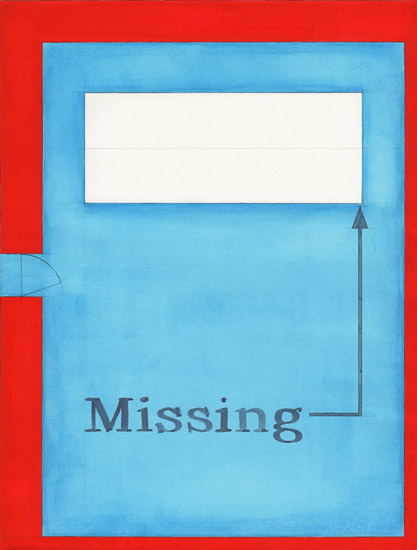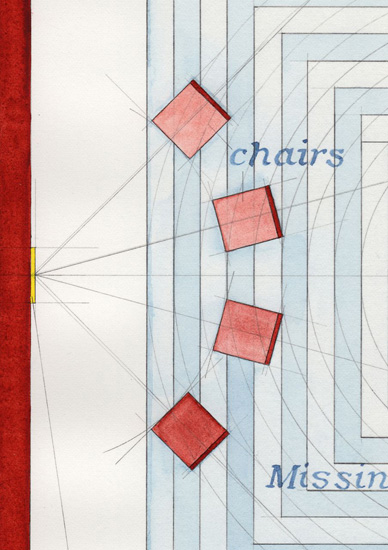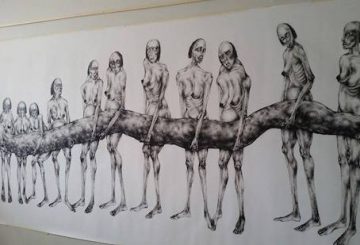Isobel Philip on Gail Hastings’ soon-to-be released e-book, Missing
Gail Hastings’ e-book, Missing, is not a catalogue or a monograph. It isn’t even really that comfortable with the moniker ‘artist book’. It stakes out an entirely different territory altogether, challenging the very limits of the ‘page’. The book is not a collection of reproduced images that serve as impoverished reiterations of pre-existing artworks. It is a compendium of four discrete artworks that assert (and preserve) their own structural self-sufficiency.
When I discovered Hastings was producing an e-book I was intrigued. As a medium with strict formal constraints, the e-book is somewhat antithetical to the nature of Hastings’ work. Designed for the digital tablet, an e-book is masquerade. It imitates the structure of a real book yet its pages are fake; pixels disguised as paper. Hastings’ (physical) work, on the other hand, does not mask its materials or camouflage itself. It is resolutely present.
Gail Hastings, Missing, 2014, an eBook of four sculptuations with Foreword by Richard Shiff, published by Pigment Publisher. page 1 of 52. Image courtesy the artist and The Commercial Gallery, Sydney
Hastings uses the term ‘sculptuation’ to define her practice. This is a term that marries ‘sculpture’ with ‘situation’ so as to shift focus away from the individuated sculptural object and towards the spatial scheme it delineates. Hastings’ objects do not operate autonomously but are bound by complex networks of action and form. Her refined geometric constructions are often accompanied by floor plans or sets of instructions thatoutline each work’s rules of engagement. They show us how to move with, or speak to, the complex spatial systems Hastings constructs.
As viewers we are required to navigate the connective tissue that links the objects to the cartographic blueprints that accompany them. We dip in and out of the space of the work; interpreting it from afar as distanced observers while simultaneously occupying territory contained within its circumference. Whether consciously or not, we are implicated in the work. We inhabit its topography. Can an e-book be enlisted to perform the same function as these object-based works? Can its screened images — floating inaccessible in the data cloud — coerce the viewer into the same tidal pull as their physical counterparts?
The sculptuations that appear in Hastings’ e-book subscribe to the same formal logic that binds her other (physical) work. They solicit a dialogue with the viewer that unravels like a mediated call and response. The syntax of this dialogue, however, is dramatically modulated in the movement from the physical world into that of the virtual.
The dynamic potential that resides in virtual space has not yet been fully apprehended. Why should a virtual book ape the form of a physical book? Surely it can possess its own architecture and pioneer its own pathways. Hastings’ work not only recognizes the possibility of such an architecture, it lays the foundations.
The first sculptuation that appears in the book, also titled Missing, begins and ends with the front and back cover. Each cover depicts an aerial floor plan of a room dominated by an unidentified rectangle. In the first room, an arrow points to the lower right hand corner of the rectangle. This corner is labeled ‘Missing’. In the second room, an arrow points to the lower left hand corner of the rectangle. That corner is labeled ‘Found’. The door that opens into the first room is positioned on the left while the door that opens into the second room is positioned on the right. These doorways are our entry and departure points into the peculiar spatial structure of the book.
This is a world in which the space of the ‘page’ is transposed into an architectonic room. The aerial floor plans that punctuate each sculptuation invite the viewer to inhabit a virtual architecture and project themselves into an imagined spatial plane. Yet the two-dimensional is never totally disavowed. Other pages embrace their status as images. The slabs of text are meant to be read (and digested) from a distance, not inhabited. Here the ‘characters’ are described in the third person. Once we stroke the screen and enter the labyrinthine anatomy of Hastings’ architecture, we realize that we are the protagonists in this narrative. The instructions have been directed at us.
Gail Hastings, Distance of Doubt, 2014. The sculptuation comprises 8 components, it’s digital pages are scanned images of physical pages, from Missing, 2014 an eBook of four sculptuations with Foreword by Richard Shiff, published by Pigment Publisher. page 25 of 52 (detail) Image courtesy the artist and The Commercial Gallery, Sydney
If we are the protagonists, what is our narrative trajectory? When we embark on this virtual tour of imagined interior spaces as peripatetic voyeurs we encounter something that is ‘missing’ — something affixed to the non-descript corner of a rectangle. By the time we get to the end of the book, it has been ‘found’. The plot line that sees ‘missing’ transposed into ‘found’ is never unraveled. The thread that binds beginning to end hangs limp. Unspoken. We aren’t even told what has been lost.
‘Missing’ is a (virtual) object — namely the book itself — but it is also a state of being, or rather a state of being displaced. The narrative trajectory mapped out in this first sculptuation revolves around an object (the book) and its transition from beginning to end but it also marks the shift in orientation between displacement and placement. This re-orientation affects us too. We are implicated in — and must ourselves navigate — this transmutation.
Copies of the book appear in each of the other three sculptuations like embedded ciphers. They lie on tables and couches in the rooms that we occupy over the course of each discrete artwork. But these meta-books are a fiction. In each watercolour floor plan, the copy of Missing looks like a physical book. It is not cradled by an iPad or tethered to any other digital device. All that is visible is the cover. Yet in reality, no physical copy of the book exists. For while the original watercolour paintings that feature throughout have a material presence, and have been exhibited individually, they have never been bound between the tangible covers of a physical book.
The Missing books that are embedded in each sculptuation — virtualized and synecdochic — trap the viewer within a looped mise-en-abîme. Their presence turns each work into a hall of mirrors.
In Corner caretakers and The distance of doubt the book lies inert on a table. In Space of a five page plot, however, it has agency. The structure of this sculptuation is based around a series of five interlinked rooms. In the first room the book appears on a couch. In the second room the couch and book have moved. In the third room the book has disappeared. It is never seen again.
The denouement of the first sculptuation (and the back cover of the book) appears after Space of a five page plot. It seems reasonable to presume that what has been ‘Found’ in this last room offers some resolution to the case of the lost book. But the object that goes missing in Space of a five page plot never existed in the first place. Missing is a non-physical book yet within this virtual world, it is a physicalized book that is lost and lamented. As we navigate this sculptuation, thrown into a plot in which we are made to look for the missing object, we are chasing the imaginary and the intangible.
The slabs of text that steer our pathway through Space of a five page plot appear under a header that reads; ‘ENCYCLOPAEDIA OF LOOKING FOR THE PLOT IN ART.’ The text that appears in the other sculptuations is similarly classified. The viewer’s passage through the book is teased out of fabricated encyclopaedia entries. This artifice — the simulacral encyclopaedia — is a metaphoric structural device that recurs throughout Hastings’ practice. The etymological origins of the term ‘encyclopaedia’ can be traced back to false reading of the Greek enkyklios paideia — interpreted as ‘general education’ but literally translatable as ‘to train in a circle’.
This linguistic genealogy seems strangely apt considering the cyclical rhythms that Hastings’ work activates. As we make our way through each sculptuation we oscillate between states of estrangement and absorption. On one page we are detached observers, the next we are consumed within the spatial logic of the work. This oscillation — a perpetual yo-yo that has the viewer confront the work as an image for contemplation and a participatory event — is cyclical. Back and forth. The yo-yo perpetuates itself.
But this is not the only cyclical rhythm that Missing excites. Each sculptuation collapses the distinction between physicalized objecthood and immaterial gesture. By this I don’t simply mean the virtualized delineation of physical space within the floor plans. More complex shifts are at play here. In The distance of doubt a set of stairs, represented according to cartographic convention as a sequence of short horizontal bars, provide a bridge between adjacent pages and the floor plans they contain. But as we travel across this juncture, the label ‘stairs’ is transposed into ‘stares’. The object has become a stage direction.
This transaction is governed by the same (warped) rationale that sees ‘page’ and ‘room’ collide and converge; stitched together as synchronic, yet distinct, spatial fields. It is the same logic that renders us capable of inhabiting such impossible spaces and has us chasing the intangible and the immaterial – trapped in that hall of mirrors. And that is precisely the point. Hastings’ work is not motivated by the stature or presence of objects but by the navigational pull they possess. It’s not what is missing that is important but that it simply is.




Pingback: Review of Missing by Isobel Philip in The Art Life: The pure potential of a page | Gail Hastings' studio